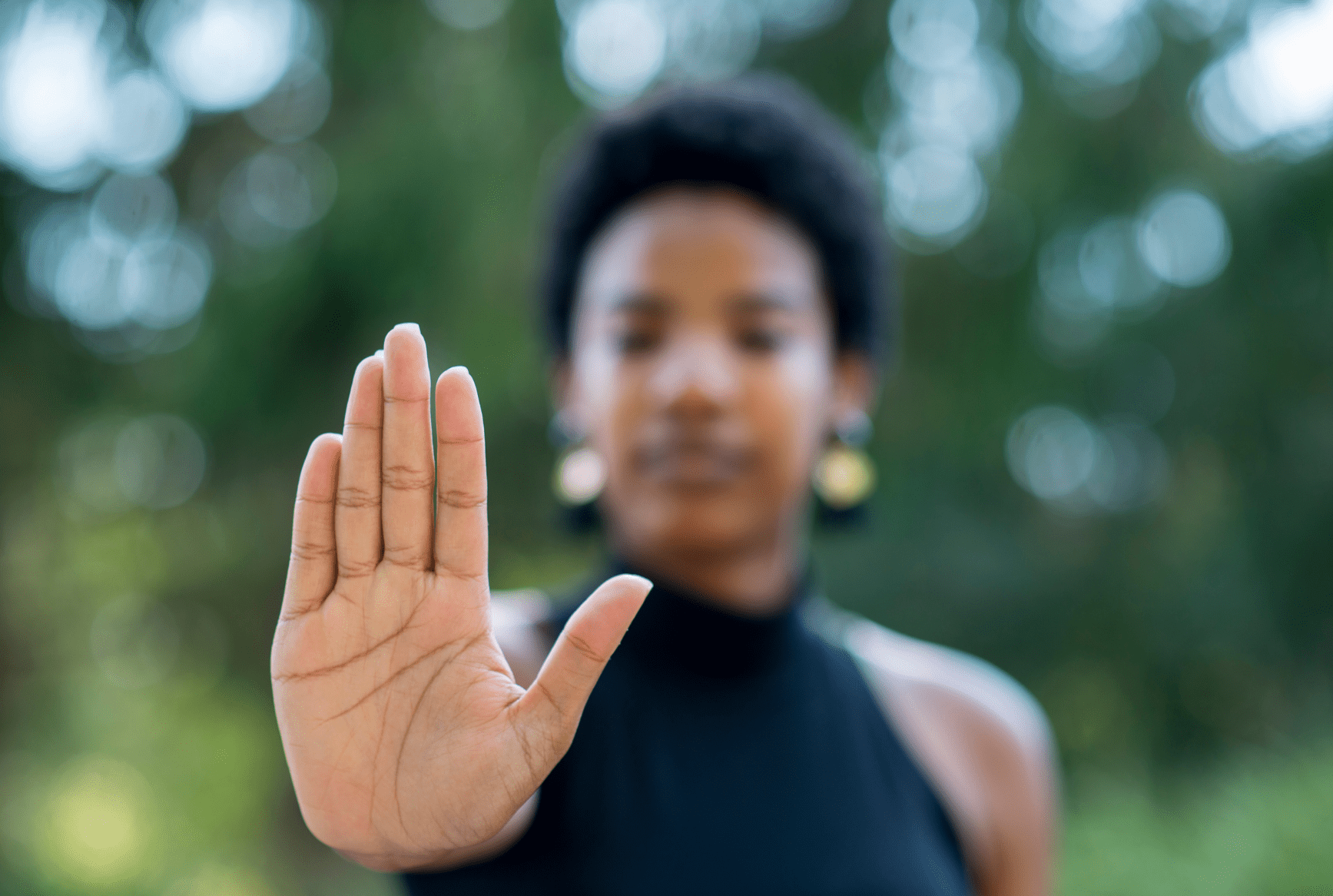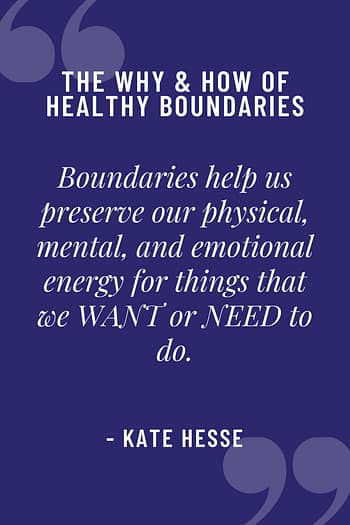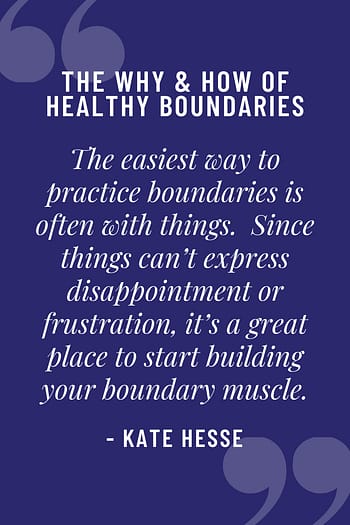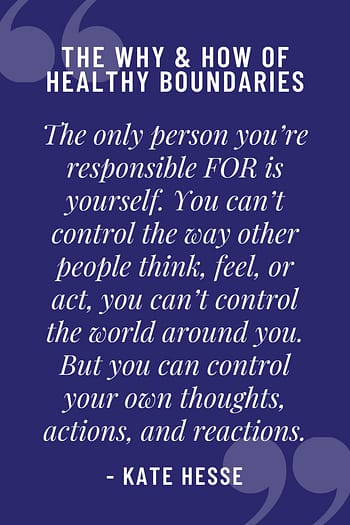
There are several ways in which healthy boundaries help us have healthy relationships.
Healthy boundaries help us ensure we have enough energy to engage with the people, and in the activities, that bring us joy. From romantic to platonic, friends, family, and co-workers, knowing when and how to incorporate personal boundaries into your relationships helps to create good relationships by removing avenues for resentment and frustration.
Whether you’re interested in relationship building, fixing existing relationships, or setting yourself up for a lasting relationship, healthy boundaries are a great place to start.
The power of healthy boundaries
Before we start talking about establishing boundaries, I think it’s helpful to understand why boundaries are important.
Boundaries help us preserve our physical, mental, and emotional energy for things that we WANT or NEED to do.
The things we WANT to do are those things that bring us joy, pleasure, and fun. The things we NEED to do are adult responsibilities like a load of laundry when we’re out of clean underwear.
Everything else, you get to decide IF you want to devote your energy to it.
 How to create a boundary
How to create a boundary
Once you’ve gotten clear on what falls onto your WANT or NEED list, everything else you have the option of saying no to. (Check out this blog post if you need more details on building your want and need lists.) And it can be as simple as that. “No.” “No, thank you.” “Thank you, but no.” “That doesn’t work for me.”
You don’t need to explain, justify, or apologize. You can simply decline any offer that you don’t want to devote your energy or resources toward.
If you’re struggling with saying no to things that are pulling your energy away from what you WANT or NEED to do, here’s another way to look at it.
Every yes is also a no
There are only so many hours in a day. If a friend calls and asks you to take care of their kids on a day you had planned to run errands or get started on an exciting project for your side hustle, you’ll have to say no to those things in order to say yes to your friend.
Alternatively, you can say no to your friend in order to say yes to what you had already planned to do with that day.
You get to choose where you want to spend your energy. To help you make that decision, grab your copy of my FREE Boundaries Quick Start Guide – use the form below or check it out here.
Ok, but how do I know where to construct a healthy boundary?
Before you vocalize your boundaries, here are some important questions to ask yourself to help determine where you want to draw the line:
- Are you currently spending more energy than you’re replenishing. A good indicator here is if you’re burnt out or consistently tired, overwhelmed, and stressed out.
- Are you resentful every time you say yes to this particular someone or something?
- Is the person seeking your assistance, time, or energy asking for help on something that’s above and beyond their everyday responsibilities? (This is a BIG grey area, work with a coach, therapist, or trust your instinct on this one.)
Now is a great time to download my free Boundaries Quick Start Guide. It will guide you through six simple yes or no questions to help you determine where you want to start drawing your boundaries with the people, situations, and things in your life.
Key Takeaways
Before we move onto the most important boundary to construct in your relationships, these are two key questions to consider when starting to construct healthy boundaries:
First make sure you’ve got enough energy to share. If you don’t then it won’t do anyone any good for you to dip into an empty well to try and help. Focus on refilling your own mental, emotional, and physical energy first. Get really good at saying no and carving out time for self-care which is the only way we refill our energy. If you struggle to figure out how to make self-care work for you and your life, get my free Self-Care Toolkit.
Second, if someone or something leaves you feeling frustrated or resentful, it’s a good indicator you’re ready to draw a boundary there. Practice saying no the next time they ask you for something.
 Your boundary muscle grows stronger with use
Your boundary muscle grows stronger with use
Boundary work is big and it can be hard. If you’re just starting to dip your toe into the pool of boundary work, I’d suggest starting with easy boundaries. Try saying no to bringing brownies to the school bake sale on the week you have a major work event.
We can construct boundaries with things, people, and ourselves.
Often the easiest way to practice boundaries is with things. Try giving away the clock you hate that your in-laws gifted to you. Or the jeans that always make you feel fat but you paid so much money for you feel guilty not wearing.
Since things can’t express disappointment or frustration, it’s a great place to start building your boundary muscle.
The most important boundary to set in a relationship
As we’ve already covered, healthy boundaries are a key component to healthy relationships.
Now let’s turn our focus to the most important boundary to set in a relationship – understanding the difference between being responsible FOR yourself and being responsible TO others.
Let’s get crystal clear – you’re not responsible FOR anyone but yourself. You can be responsible TO those who are in need above and beyond their everyday responsibilities. But you are not responsible FOR the thoughts, actions, or needs of anyone but yourself.
The one exception here is if you’re the parent to young children. As your children get older, your job is to gradually teach them to be responsible FOR themselves as you shift to being responsible TO them.
 If you’re asking questions about healthy boundaries, it means that you’ve realized an important fact which took me many years to understand. Healthy boundaries are important for healthy relationships.
If you’re asking questions about healthy boundaries, it means that you’ve realized an important fact which took me many years to understand. Healthy boundaries are important for healthy relationships.
You are ONLY responsible FOR yourself
In a relationship it’s critical to set boundaries which distinguish between being responsible FOR and being responsible TO the other person.
Let’s break that down. The only person you’re responsible FOR is yourself. You can’t control the way other people think, feel, or act, you can’t control the world around you. But you can control your own thoughts, actions, and reactions.
You are responsible TO the people in your life. This means showing up and treating them with respect and care. It means choosing to spend mental, physical, and emotional energy on being present for them in a way that is not detrimental to being present for yourself.
Healthy boundaries aren’t just to protect you
In a relationship when you try to step over this line and attempt to be responsible FOR someone else, you set up an unhealthy dynamic. You disempower them. The message you’re sending is that you don’t trust them to be able to handle whatever it is that you’re assuming responsibility for. You’re also exempting them from having to take responsibility for themselves.
This ultimately leads to resentment on both sides as one person in the relationship feels burdened by carrying the other person’s responsibility and the other feels like they aren’t trusted to be responsible for themselves.
In any relationship (friend, family, co-worker, romantic or platonic) the most important boundary you can set is taking responsibility FOR your own thoughts, feelings, words, and action. And NOT taking responsibility FOR the thoughts, feelings, words, and action of the other person.
That means taking responsibility not only for what you do right, but also taking responsibility and ownership when you make a mistake. And it means allowing the people in your life to take responsibility for the things they do right, and for their mistakes.
It’s important to do this in a way that’s respectful, compassionate, and clear.
Ask for help – you don’t need to be in this alone!
This is all a lot easier to say than to do, it involves a lot of grey areas, and can be confusing. AND it’s incredibly rewarding and beneficial. If you’re just beginning to explore boundaries a coach can be invaluable to offer insight and guidance as you learn to navigate many of these grey areas.
There’s often a big self-worth and self-love component that comes into play when we begin to enforce boundaries, and a coach or therapist can also be helpful as you work through these things.
If you’re interested in learning more about what working with a coach would be like, schedule a no-cost Discovery Session with me and let’s start the conversation.
I’m sending you a great big hug – you’ve got this!
If you enjoyed this episode of Solicited Advice, check out other episodes, and while you’re there, make sure you subscribe to my YouTube Channel so you don’t miss out on future episodes released each Monday & Thursday!
Related
Leave a Reply Cancel reply
This site uses Akismet to reduce spam. Learn how your comment data is processed.